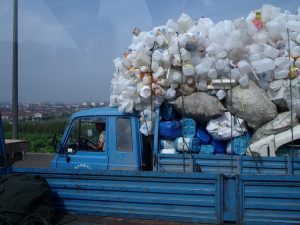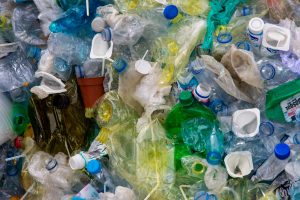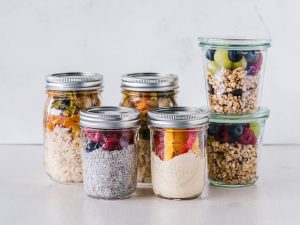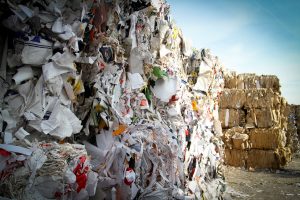The Recycling Landscape is Changing — Are You an Adapter?
By Emily Hill, guest blogger

Source: Paul Louis on Wikimedia Commons (CCO)
Recycling has been touted for decades as a solution to such ecological travesties as the Great Pacific Garbage Patch. As a result over a third of Americans conscientiously wash and separate their plastic, glass, and cardboard, encouraged by incentives such as free pickup and cash refunds. Historically, many tons of recyclables have been shipped overseas to supply manufacturing plants. This process helped to keep some dirty realities out of sight, such as the environmental health crises plastic waste was causing for the communities receiving it.
This happy bubble popped in 2017 when China, after repeated warnings about the poor quality of American recyclables, announced it would no longer accept certain types of mixed plastics and cardboard. The decision set off a scramble to find an alternative solution, but unfortunately there aren’t many countries that want our 50 billion plastic bottles or the cardboard from 165 billion packages.
How had we gotten here? Recycling had been the sold to us as the best way for everyday Americans to reduce waste. Instead, waste produced by the U.S. has more than doubled since the first Earth Day in 1970. We’ve taken recycling for granted and grown comfortable ignoring the reduce and reuse parts of the old ‘Three R’s’ adage.
In its 2016 “The New Plastics Economy” report, the World Economic Forum warned that thirty years from now there may be more plastic waste in the oceans than fish. If we want to avoid that future, we’ve got to take short and long-term steps to emphasize reduction, increase reuse, and raise the effectiveness of recycling.

Source: Magda Ehlers on Pexels (CCO)
Some Basic Rules
-
Reduce judiciously
We are led to believe that the presence of the “chasing arrows” icon on many plastics indicates that the item is recyclable. In reality, the number at its center simply indicates the type of resin in the plastic – the recycling industry is in no way required to recycle an item with this symbol.
However, if you’re trying to decide which plastics to avoid, the arrows can be a useful guide. There is a larger market for items with numbers one and two, while items with three, four, five, and six may end up in a landfill. To learn more about which items should be prioritized for reduction and reuse, see this Bay Area special by the Mercury News.
-
Reuse more
Be savvy about replacement products. Many companies are trying to market single-use items as compostable or biodegradable. However, “biodegradable plastics” can refer to a huge range of products, not all of which are compostable or even recyclable. It includes plastics made from plant biomass, but it also includes petroleum-derived products that break down rapidly when exposed to air and light, leaving behind toxic residue and plastic fragments. Many municipalities refuse to accept any sort of compostable bioplastic because they don’t want to risk introducing chemicals to their compost; these plant-based plastics then end up in landfills where they contribute to methane release.

Source: Ella Olson on Pexels (CCO)
Just as the chasing arrows can be misleading, so can the label “compostable” or “biodegradable.” It’s always better to avoid single-use items and find reusable products that work for your life.
-
Recycle better
The truth is, in the short term we can’t control what types of plastic will be in demand for recycling from one day to the next. We do know, however, that for any item to be recycled it must be clean and dry; for this reason, many municipalities are moving away from the more convenient single-stream approach in favor of a dual stream. If your city has dual stream recycling, do your best to keep your cardboard and paper separate from plastic and glass so there’s no cross-contamination.
-
Compost instead
As municipal curbside compostable collection has increased, we must become savvier about whether to recycle or compost paper. Office paper is made using long fibers of wood – this makes it durable and more impervious to water (as anyone who has ever spilled a cup of coffee on a work report can attest). This resilience also makes dry office paper ideal for recycling.
But every time the wood fibers that make up that piece of paper are recycled, they get shorter and become easier to tear as well as more water absorbent; this makes them ideal for toilet paper and paper towels, but not strong enough to stand up to another round of recycling. At this point it’s better to compost, especially paper that’s contaminated by food or other organic particles.
Beyond Individual Choice – the Future of Reduce, Reuse, Recycle on a Societal Scale
As with most environmental problems, recycling reform is embedded in both the small, everyday choices of individuals and the decisions made by policymakers and corporations. Online retailers have started to move in the direction of reducing waste, as with Amazon’s “frustration-free packaging.” Companies such as Emeryville-based LimeLoop are experimenting with reusable shipping packages.
Some states are passing laws to prioritize reuse; for instance, Oregon has implemented a statewide refillable bottles program. The California legislature is considering a whole host of bills related to recycling; you can follow them on CalRecycle’s website.
As with many environmental problems, the future of American recycling feels overwhelming at the moment. But it’s possible to use this discomfort to both instigate habitual changes in our own lives and demand a renewed commitment to substantial waste reduction policies from our government.

